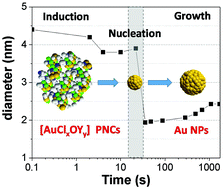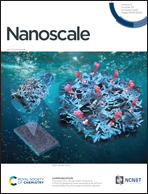The role of pre-nucleation clusters in the crystallization of gold nanoparticles†
Abstract
The syntheses of metal nanoparticles by reduction in apolar solvents in the presence of long chain surfactants have proven to be extremely effective in the control of the particle size and shape. Nevertheless, the elucidation of the nucleation/growth mechanism is not straightforward because of the multiple roles played by surfactants. The nucleation stage, in particular, is very difficult to describe precisely and requires in situ and time-resolved techniques. Here, relying on in situ small angle X-ray scattering (SAXS), X-ray absorption spectroscopy (XAS) and high-energy X-ray diffraction (HE-XRD), we propose that ultra-small gold particles prepared by reduction of gold chloride in a solution of oleylamine (OY) in hexane with triisopropylsilane do not follow a classical nucleation process but result from pre-nucleation clusters (PNCs). These PNCs contain Au(III) and Au(I) precursors; they are almost stable in size during the induction stage, as shown by SAXS, prior to undergoing a very fast shrinkage during the nucleation stage. The gold speciation as a function of time deduced from the XAS spectra has been analyzed through multi-step reaction pathways comprising both highly reactive species, involved in the nucleation and growth stages, and poorly reactive species acting as a reservoir for the reactive species. The duration of the induction period is related to the reactivity of the gold precursors, which is tuned by the coordination of OY to the gold complexes, while the nucleation stage was found to depend on the size and reactivity of the PNCs. The role of the PNCs in determining the final particle size and structure is also discussed in relation to previous studies. The multiple roles of OY, as the solubilizing agent of the gold salt, the ligand of the gold complexes determining both the size of the PNCs and the reactivity of the gold precursors, and finally the capping agent of the final gold particles as oleylammonium chloride, have been clearly established. This work opens new perspectives to synthesize metal NPs via metal–organic PNCs and to define new synthesis routes for nanoparticles that may present structure and morphologies different from those obtained by the classical nucleation routes.

- This article is part of the themed collection: Spectroscopy and scattering for chemistry


 Please wait while we load your content...
Please wait while we load your content...